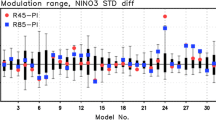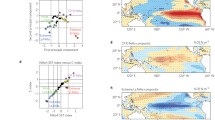Abstract
The El Niño-Southern Oscillation (ENSO) is the greatest climate variability on interannual time scale, yet what controls ENSO amplitude changes under global warming (GW) is uncertain. Here we show that the fundamental factor that controls the divergent projections of ENSO amplitude change within 20 coupled general circulation models that participated in the Coupled Model Intercomparison Project phase-5 is the change of climatologic mean Pacific subtropical cell (STC), whose strength determines the meridional structure of ENSO perturbations and thus the anomalous thermocline response to the wind forcing. The change of the thermocline response is a key factor regulating the strength of Bjerknes thermocline and zonal advective feedbacks, which ultimately lead to the divergent changes in ENSO amplitude. Furthermore, by forcing an ocean general circulation mode with the change of zonal mean zonal wind stress estimated by a simple theoretical model, a weakening of the STC in future is obtained. Such a change implies that ENSO variability might strengthen under GW, which could have a profound socio-economic consequence.












Similar content being viewed by others
References
Ashok K, Behera SK, Rao SA, Weng H, Yamagata T (2007) El Niño Modoki and its possible teleconnection. J Geophys Res 112. doi:10.1029/2006JC003798
Cai W et al (2014) Increasing frequency of extreme El Nino events due to greenhouse warming. Nat Clim Change 4:111–116
Cai W et al (2015a) ENSO and greenhouse warming. Nature Clim Change 5:849–859 doi:10.1038/nclimate2743
Cai W et al (2015b) Increased frequency of extreme La Niña events under greenhouse warming. Nat Clim Change 5:132–137
Chang P, Philander SG (1994) A coupled ocean-atmosphere instability of relevance to the seasonal cycle. J Atmos Sci 51:3627–3648
Chen L, Li T, Yu Y (2015) Causes of strengthening and weakening of ENSO amplitude under global warming in four CMIP5 models. J Clim 28:3250–3274. doi:10.1175/jcli-d-14-00439.1
Chung P-H, Li T (2013) Interdecadal relationship between the mean state and El Niño Types*. J Clim 26:361–379
Collins M et al (2010) The impact of global warming on the tropical Pacific Ocean and El Niño. Nature Geosci 3:391–397
DiNezio PN, Clement AC, Vecchi GA, Soden BJ, Kirtman BP, Lee S-K (2009) Climate response of the equatorial Pacific to global warming. J Clim 22:4873–4892
Ding R, Li JP (2012) Influences of ENSO teleconnection on the persistence of sea surface temperature in the Tropical Indian Ocean. J Clim 25:8177–8195. doi:10.1175/JCLI-D-11-00739.1
Feng J, Li JP (2011) Influence of El Niño Modoki on spring rainfall over south China. J Geophys Res Atmos 116:D13102. doi:10.1029/2010jd015160
Feng J, Li JP (2013) Contrasting impacts of two types of ENSO on the boreal spring Hadley circulation. J Clim 26:4773–4789. doi:10.1175/JCLI-D-12-00298.1
Feng J, Li J, Zhu J, Liao H (2016) Influences of El Niño Modoki event 1994/1995 on aerosol concentrations over southern China. J Geophys Res Atmos 121:2015JD023659. doi:10.1002/2015jd023659
Guilyardi E et al (2009) Understanding El Nino in ocean–atmosphere general circulation models. Bull Amer Meteor Soc 90:325–340
Ham Y-G, Kug J-S (2016) ENSO amplitude changes due to greenhouse warming in CMIP5: Role of mean tropical precipitation in the twentieth century. Geophys Res Lett 43. doi:10.1002/2015gl066864
Jin F-F (1997) An equatorial ocean recharge paradigm for ENSO. Part I: conceptual model. J Atmos Sci 54:811–829
Kao HY, Yu JY (2009) Contrasting eastern-Pacific and central-Pacific types of ENSO. J Clim 22:615–632
Karori MA, Li JP, Jin F-F (2013) The asymmetric influence of the two types of El Niño and La Niña on summer rainfall over Southeast China. J Clim 26:4567–4582. doi:10.1175/JCLI-D-12-00324.1
Kim ST, Cai W, Jin F-F, Santoso A, Wu L, Guilyardi E, An S-I (2014) Response of El Nino sea surface temperature variability to greenhouse warming. Nat Clim Change 4:786–790 doi:10.1038/nclimate2326
Kug JS, Jin FF, An SI (2009) Two types of El Niño events: cold tongue El Niño and warm pool El Niño. J Clim 22:1499–1515
Larkin NK, Harrison DE (2005) On the definition of El Niño and associated seasonal average US weather anomalies. Geophys Res Lett 32:L13705. doi:10.1029/2005gl022738
Latif M, Keenlyside N (2009) El Niño/Southern Oscillation response to global warming. Proc Natl Acad Sci 106:20578–20583
Li T (1997) Phase transition of the El Niño-southern oscillation: a stationary SST mode. J Atmos Sci 54:2872–2887
Li T, Zhang Y, Lu E, Wang D (2002) Relative role of dynamic and thermodynamic processes in the development of the Indian Ocean dipole: an OGCM diagnosis. Geophys Res Lett 29:25-21-25-24
Lindzen RS, Nigam S (1987) On the role of sea surface temperature gradients in forcing low-level winds and convergence in the tropics. J Atmos Sci 44:2418–2436
Liu L, Yu W, Li T (2011) Dynamic and thermodynamic air–sea coupling associated with the Indian Ocean dipole diagnosed from 23 WCRP CMIP3 models*. J Clim 24:4941–4958
Liu H, Lin P, Yu Y, Zhang X (2012) The baseline evaluation of LASG/IAP climate system ocean model (LICOM) version 2. Acta Meteorol Sin 26:318–329
McCreary JP Jr, Lu P (1994) Interaction between the subtropical and equatorial ocean circulations: the subtropical cell. J Phys Oceanogr 24:466–497
McPhaden MJ, Zebiak SE, Glantz MH (2006) ENSO as an integrating concept in earth science. Science 314:1740–1745. doi:10.1126/science.1132588
Merryfield WJ (2006) Changes to ENSO under CO2 doubling in a multimodel ensemble. J Clim 19:4009–4027
Neelin JD (1991) The slow sea surface temperature mode and the fast-wave limit: analytic theory for tropical interannual oscillations and experiments in a hybrid coupled model. J Atmos Sci 48:584–606
Philander SG (1990) El Niño, La Niña, and the southern oscillation. Academic Press, London
Power S, Delage F, Chung C, Kociuba G, Keay K (2013) Robust twenty-first-century projections of El[thinsp]Nino and related precipitation variability. Nature 502:541–545. doi:10.1038/nature12580
Rashid HA, Hirst AC, Marsland SJ (2016) An atmospheric mechanism for ENSO amplitude changes under an abrupt quadrupling of CO2 concentration in CMIP5 models. Geophys Res Lett 43:2015GL066768. doi:10.1002/2015gl066768
Sadekov AY, Ganeshram R, Pichevin L, Berdin R, McClymont E, Elderfield H, Tudhope AW (2013) Palaeoclimate reconstructions reveal a strong link between El Nino-Southern Oscillation and Tropical Pacific mean state. Nat Commun 4 doi:10.1038/ncomms3692
Stevenson SL (2012) Significant changes to ENSO strength and impacts in the twenty-first century: Results from CMIP5. Geophys Res Lett 39:L17703. doi:10.1029/2012gl052759
Su J, Zhang R, Li T, Rong X, Kug J, Hong C-C (2010) Causes of the El Niño and La Niña amplitude asymmetry in the equatorial eastern Pacific. J Clim 23:605–617
Su J, Li T, Zhang R (2014) The initiation and developing mechanisms of central Pacific El Niños. J Clim 27:4473–4485
Taylor KE, Stouffer RJ, Meehl GA (2012) An overview of CMIP5 and the experiment design. Bull Am Meteorol Soc 93:485
Van Oldenborgh GJ, Philip S, Collins M (2005) El Niño in a changing climate: A multi-model study. Ocean Sci Discuss 1:81–95
Wang B, Li T (1993) A simple tropical atmosphere model of relevance to short-term climate variations. J Atmos Sci 50:260–284
Wang C, Weisberg RH (1994) On the “Slow Mode” mechanism in ENSO-related coupled ocean–atmosphere models. J Climate 7:1657–1667
Xiang B, Wang B, Li T (2013) A new paradigm for the predominance of standing Central Pacific Warming after the late 1990s. Clim Dyn 41:327–340
Xie SP, Deser C, Vecchi GA, Ma J, Teng H, Wittenberg AT (2010) Global warming pattern formation: sea surface temperature and rainfall*. J Clim 23:966–986
Yeh S-W, Kirtman BP (2007) ENSO amplitude changes due to climate change projections in different coupled models. J Clim 20:203–217
Yeh SW, Kug JS, Dewitte B, Kwon MH, Kirtman BP, Jin FF (2009) El Niño in a changing climate. Nature 461:511–514
Zelle H, van Oldenborgh GJ, Burgers G, Dijkstra H (2005) El Niño and greenhouse warming: results from ensemble simulations with the NCAR CCSM. J Clim 18:4669–4683
Zhang W, Jin F-F (2012) Improvements in the CMIP5 simulations of ENSO-SSTA meridional width. Geophys Res Lett. doi:10.1029/2012GL053588
Zhang L, Li T (2014) A simple analytical model for understanding the formation of sea surface temperature patterns under global warming. J Clim 27:8413–8421. doi:10.1175/jcli-d-14-00346.1
Zhang W, Li J, Jin FF (2009) Spatial and temporal features of ENSO meridional scales. Geophys Res Lett 36. doi:10.1029/2009GL038672
Zhang W, Jin F-F, Zhao J-X, Qi L, Ren H-L (2013a) The possible influence of a nonconventional El Niño on the severe autumn drought of 2009 in Southwest China. J Clim 26:8392–8405. doi:10.1175/JCLI-D-12-00851.1
Zhang W, Jin F-F, Zhao J-X, Li J (2013b) On the bias in simulated ENSO SSTA meridional widths of CMIP3 models. J Clim 26:3173–3186
Acknowledgements
We would like to thank Dr. Lu Wang and anonymous reviewers for insightful suggestions and comments. We acknowledge the PCMDI for providing the CMIP5 model data, which may be obtained from the website of http://pcmdi9.llnl.gov/esgf-web-fe/. This work was supported by NSFC project 41630423, National 973 project 2015CB453200, NSF AGS-1565653, NSFC 41475084, NRL grant N00173-161G906, Jiangsu NSF project BK20150062, Jiangsu Shuang-Chuang Team (R2014SCT001), NSFC Grant 41376002/41606011/41530426, CAS Strategic Priority Project XDA11010105, and by the IPRC that is sponsored by Japan Agency for Marine-Earth Science and Technology (JAMSTEC). This is SOEST contribution number 9938, IPRC contribution number 1237, and ESMC contribution 150.
Author information
Authors and Affiliations
Corresponding author
Appendix: A simple theoretical model
Appendix: A simple theoretical model
Based on a simplified Lindzen–Nigam model (Lindzen and Nigam 1987; Wang and Li 1993), boundary-layer zonal and meridional wind fields may be written as:
in which u (v) denotes the mean zonal (meridional) wind field averaged in the boundary layer, T denotes the mean sea surface temperature, f represents the Coriolis parameter, E represents the frictional coefficient (10−5 s−1), \(\text{A}=R\frac{{{p}_{s}}-{{p}_{e}}}{2{{p}_{e}}}\) is the SST-gradient forcing coefficient, R is the gas constant for dry air (287 J K−1 kg−1), p e denotes the pressure at top of the boundary layer (850 hPa), and p s denotes the pressure at bottom of the boundary layer (1000 hPa).
Applying a zonal (0°–360°E) average operator to Eqs. (7, 8), we have
where “[]” represents the zonal average. Thus, we can obtain
Assuming coefficients A and E are constant in the present-day and future global warming climate states, one may obtain
where δ means the future changes (using GW minus PD).
The change of zonally-averaged mean zonal wind stress (i.e., \(\delta [{{\tau }_{x}}]\)) may be determined by the following equation
where \({{\tau }_{\text{x}}}\) denotes the mean zonal wind stress field, \({{\rho }_{a}}\) denotes the atmosphere density (1.29 kg m−3), C D denotes the drag coefficient (1.5 × 10−3), and \(\left| {\vec{V}} \right|\) denotes the surface wind speed in PD.
Rights and permissions
About this article
Cite this article
Chen, L., Li, T., Yu, Y. et al. A possible explanation for the divergent projection of ENSO amplitude change under global warming. Clim Dyn 49, 3799–3811 (2017). https://doi.org/10.1007/s00382-017-3544-x
Received:
Accepted:
Published:
Issue Date:
DOI: https://doi.org/10.1007/s00382-017-3544-x




